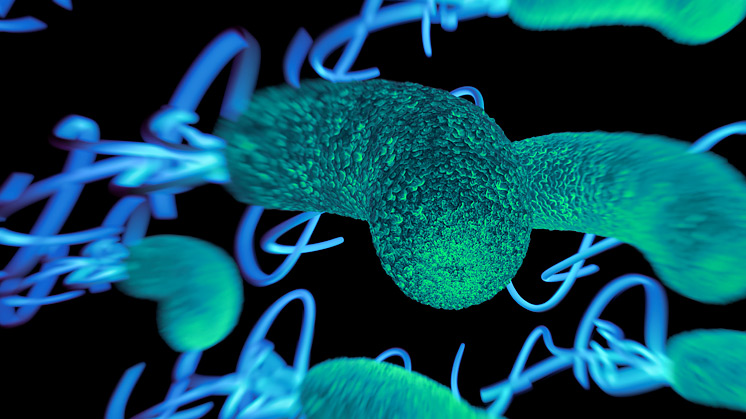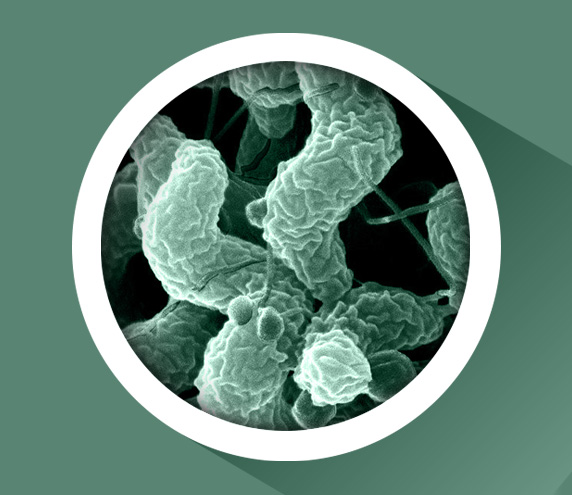Introduction to campylobacter

Introduction
Food poisoning is not a new phenomenon, but the number of reported cases has increased steadily over the last few years and recently there has been an increasing amount of public interest in the subject.
People are becoming more aware and concerned about this type of illness and no longer assume that ‘tummy upsets’ must simply be endured. This view is right, because food poisoning is almost always preventable.
Campylobacter is a pathogen that has become the most common cause of bacterial food poisoning worldwide. Over 50% of cases in the UK can be attributed to fresh chicken which is why industry has invested a significant amount of resource and is committed to reduce the levels of campylobacter.
Food originates in fields and farms and it is constantly exposed to a wide range of micro-organisms present in the environment. Campylobacter is a naturally occurring bacterium that does not cause ill-effects in chickens. We have to accept that all fresh and natural foods may contain microbes that have the potential to be harmful if food is not handled and prepared correctly.
Everyone has a part to play in reducing the risks of bacterial food poisoning. Food safety must be observed ‘from farm to fork’; by producers, retailers, cooks, consumers, distributers.
It is important to note that appropriate storage and handling of food and thorough cooking will eliminate the risk of bacterial food poisoning.
This paper gives facts about campylobacter and information on the safe handling of foods, particularly products like poultry and meat.
Bacteria
Bacteria are simple organisms consisting of one cell. They are very tiny, usually spherical, oval, or rod-shaped and 500 typical cells would cover a pin head. Bacteria can be found almost everywhere in our environment.
They grow in soil, water, vegetation, and in humans and animals. Most bacteria are harmless and some are beneficial but some, termed pathogens, can cause illness.
Bacteria need water, warmth, and food to grow well. Growth can be very rapid; under ideal conditions one bacterium may multiply to 70,000 million bacteria in about twelve hours. Food poisoning bacteria will not grow in the freezer, or at temperatures above 60C. The optimum temperature for the growth of food-poisoning bacteria is 20C to 45C. Outside these temperatures growth slows and at refrigeration temperatures (-2C to +4C), most dangerous bacteria do not grow at all.
Campylobacter
Campylobacter is a genus (group) of bacteria which has a characteristic curved ‘S’ or spiral shape. This group of bacteria has been known to cause illness to animals for about 70 years, but its ability to cause illness in humans only began to be fully appreciated in the mid-1970s.
Since then, campylobacter has been the commonest cause of gastrointestinal infections in the UK. By 1988 there were over 28,000 reported cases, and by 2013 this had risen to over 70,000. Globally, campylobacter is one of the most frequent causes of diarrhoea.
There are several species of campylobacter that can cause illness in people; campylobacter jejuni is the commonest in the UK and in most countries.
In people, symptoms of campylobacter infection develop 1 to 4 days after ingesting the bacteria and infection may vary from mild diarrhoea to acute enteritis characterised by fever, headache, diarrhoea, and cramping abdominal pain. Deaths are very rare. The symptoms usually last for a few days, followed by recovery, but in about 25 percent of sufferers the bacteria is not immediately eliminated and relapses occur over several weeks. Campylobacter can have long-term effects for a minority of sufferers depending on the severity of infection; Irritable Bowel Syndrome (IBS), reactive arthritis or Guillain-Barré Syndrome which causes paralysis. Medical help should be sought for any lingering intestinal infections.
Campylobacter can occasionally cause illness in animals but it is very commonly found as part of the normal flora of healthy animals. Cattle, poultry, sheep, pigs, dogs, cats, and other domestic and wild animals all carry campylobacter. Pets in the home can pass campylobacter to their owners. Campylobacter is also very widely spread in the environment. Campylobacter in foods
Raw poultry, beef, offal and other meats as well as unpasteurised milk are the foods most likely to contain campylobacter. Unlike most other food poisoning organisms, campylobacter grows very poorly in food, and the numbers of this bacterium tend to decline as food is stored. Also, this bacterium prefers to grow in conditions where oxygen levels are reduced. However, campylobacter survives at refrigeration temperatures. Other foods are easily cross-contaminated by soiled surfaces, dirty equipment, dirty utensils, and dirty water.
Pets should not be allowed near food or food equipment and their feeding bowls should be washed and dried separately from other household washing-up.
Campylobacter has been termed the ‘barbecue bug’, but there is no special relationship between this bacterium and barbecues. Problems arise at barbecues because people are tempted to handle cooked food with hands contaminated by raw food or to eat the food before it is properly cooked. Barbecued food looks ready and smells delicious well before it is actually cooked through. If such half-cooked food is eaten, food poisoning by campylobacter, salmonella, and other bacteria may follow.
Cooking kills campylobacter
Campylobacter is killed by heat, so proper cooking completely eliminates this bacterium. Poultry and meat of all types, fish, eggs, and pastry products need to be heated through to 70C or higher and held at this temperature for at least two minutes.
It is important to be sure that the centre of the food is adequately heated. Manufacturers’ cooking instructions, where given, must be carefully followed. Thermometers are used to check temperatures in professional catering operations, and they can be used in the home. Without a thermometer, poultry and meat can be tested by putting a skewer into the centre of the food to see if the juices run clear. If the juices are pink or red, more cooking is needed. Barbecued food should also be checked with a skewer.
Control of campylobacter in poultry and meat
Apart from proper cooking, campylobacter control depends on the prevention of cross-contamination, careful attention to hygiene i.e. washing hands, utensils and equipment, and the correct storage of food.
Cross-contamination
Campylobacter must not be passed from raw to ready-to-eat foods.
This means preventing raw meat, fish and eggs from dripping over other foods, and washing up all utensils, plates, working surfaces, chopping boards, knives, etc immediately after use so they cannot be inadvertently used on ready-to-eat foods.
Hot soapy water is needed, and dishcloths should be cleaned by soaking in disinfectant such as bleach after use with raw poultry and meat.
Storage
Fresh produce should be refrigerated as soon as possible. Refrigerators should be set at between 0C and 4C; a thermometer will be needed to check the temperature. Campylobacter does not grow below 4C.
Frozen poultry must be completely defrosted before cooking. Be sure there is no ice inside the bird, and that joints are not stiff.
Once the food has been cooked, it should be eaten immediately, or allowed to cool and placed in the refrigerator as soon as possible. Sandwiches, prepared salads, and cold dishes should also be refrigerated if not for immediate consumption.
Cooked foods must be stored at the top of the fridge and raw foods at the bottom on a tray or plate. Raw foods tend to drip. These drips could contain bacteria that may contaminate other foods. All foods should be covered or stored in sealed containers.
Poultry producers
Today the poultry industry is more carefully regulated and managed than ever before. Government hygiene regulations are being revised and strengthened, and updated Codes of Practice backed by inspections are being followed by producers, processors and retailers.
Stringent measures are taken to control pathogens in poultry. A better understanding of food hygiene by all concerned with food preparation will prevent unnecessary illness.
For more information on what the industry and government are doing in the fight against campylobacter please visit www.campylobacter.org.uk

